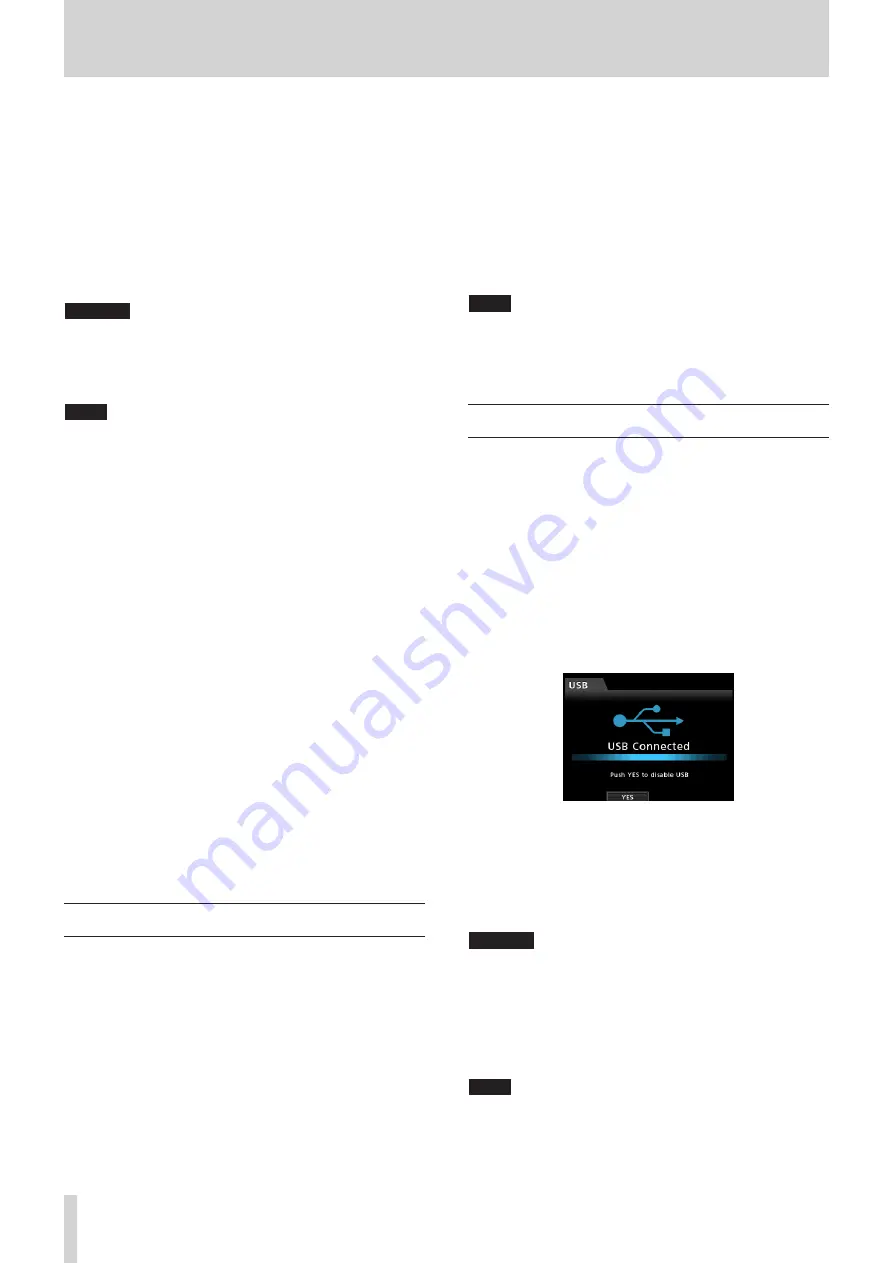
64
TASCAM DP-32SD
13 - Exchanging Data with a Computer
By connecting this unit to a computer using the USB cable, you
can backup song data from an SD card in the unit to a computer
and restore backed-up song data from a computer to the card.
In addition, you can export track files and stereo master files
from songs to the computer, as well as import audio files from
the computer to the unit.
Backed-up data can be restored to a different DP-32SD unit
than the one that created it. In other words, files can be freely
exchanged between DP-32SD units, making it easy to add
additional recordings or mix existing recordings in different
location.
CAUTION
If you want to remove an SD card from this unit and
back up its data on a computer using a card reader,
always turn off the unit's power before removing the
card.
NOTE
In this chapter, "computer" refers to a Windows or Macintosh
personal computer connected to this unit. (See "Operating system
requirements" in the following section.)
The following types of data can be transferred from this unit to a
computer.
ª
Entire songs
You can transfer the data for an entire song from the unit's
MUSIC
folder to a computer. This operation is called "backing up".
In addition, data backed up on a computer can be transferred to
the
MUSIC
folder, and then restored as a song file. This operation
is called "restoring".
ª
WAV format tracks
Export specified track files as WAV files to the
AudioDepot
folder
of the SD card. In addition, you can import specified track files
by storing WAV files from a computer in the
AudioDepot
folder
beforehand.
In other words, data transfer between the computer and track
files is carried out through the
AudioDepot
folder.
ª
Master file
A master file created on this unit can be transferred to a
computer as a stereo WAV file (from the "Song name" folder
inside the
MUSIC
folder).
Only export of the master file is possible.
Operating system requirements
You can connect this unit to computers with the following
operating systems.
ª
Windows
Windows 8 (including 8.1)
Windows 7
Windows Vista
Windows XP
ª
Mac OS X
Mac OS X Mavericks (10.9)
Mac OS X Mountain Lion (10.8)
Mac OS X Lion (10.7)
Mac OS X Snow Leopard (10.6)
When this unit is connected to a computer, the computer
recognizes it as a removable disk. There is no need for a special
driver.
NOTE
Data transfer between this unit and a computer occurs at USB 2.0
speed (maximum). Data can still be transferred if the computer
connection is USB 1.1, but it will be slower. In addition, to assure
USB 2.0 speed, use a cable that meets USB 2.0 standards.
Connecting to a computer
When connected to a computer via USB, this unit's record,
playback and other recorder functions cannot be used.
To connect with a computer, use a mini-B-type USB 2.0 cable to
connect the USB port on the rear panel of the unit with a USB
port on the computer.
It does not matter whether you turn the unit's power ON before
or after the USB connection is made.
When this unit is ON, enable the USB connection with the
USB
item of the
MENU
screen.
The currently loaded song is saved before the USB connection
becomes effective. When connected, the following screen
appears on the display.
After making a USB connection, you must turn the power on and
enable the USB connection in the
USB
item of the
MENU
screen.
This unit appears as an external drive named
DP-32SD
on the
computer's display.
Clicking on the
DP-32SD
drive will display the
MUSIC
,
UTILITY
,
and
AudioDepot
folders.
CAUTION
• Be sure to use the included GPE248-120200-Z AC adaptor
to supply power to this unit. Power cannot be supplied to
this unit via USB.
• Do not disconnect the AC adaptor or otherwise cut the
power to the unit during data transfer. Doing so will cause
all the data to be lost beyond recovery.
• Do not change the names of folders inside the
DP-32SD
.
NOTE
The
UTILITY
folder is used, for example, to update the system
software used by the unit. In addition, do not delete or change the
names of individual files in the
Song
subfolder inside the
MUSIC
folder. You can, however, delete an entire
Song
folder if you no
longer need that song.



























